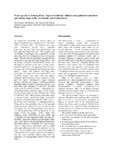Water quality in Imbang river, Negros Occidental: effluents and pollutant loads from agriculture, sugar mills, households, and shrimp farms
- Global styles
- MLA
- Vancouver
- Elsevier - Harvard
- APA
- Help
Share
抄録
An ecological assessment of Imbang River in Negros Occidental was undertaken from December 1992 to February 1995. The effluents from sugar mills, households, shrimp farms, sugarcane plantations and rice fields were characterized and their pollutant loads estimated. Water quality and invertebrate assemblages were analyzed at several sites along the river to determine the environmental status. Results showed significant seasonal and site variations in water quality along Imbang River. The dry season, coinciding with the milling season, was the more critical time of the year as water quality tended to deteriorate. The segments of the river near the sugar mills and households had the poorest water quality. Sugar mill effluents had high water temperature (average 33oC but as high as 50oC), low dissolved oxygen, high total solids, the highest settleable solids (average 2.5 and as high as 17 m/l), and the highest biochemical oxygen demand (average 259 ppm but as high as 14,800 ppm BOD). Domestic effluents had low pH, high ammonia, very high BOD, plus detergents or surfactants and high levels of fecal coliform bacteria. Agricultural runoff had high nitrate, high total solids, and the highest total suspended solids (average 296 ppm but as high as 5,095 ppm TSS). Shrimp ponds used saline water of average 23 ppt, and had the highest total solids (average 23,456 ppm and as high as 57,400 ppm). By far the major contributor of pollutant loads into Imbang River was agriculture, due to its huge areal extent and huge volume of water use and run-off. Agricultural run-off carried the highest annual loads of 7,858 kg phosphate; 6,495 kg ammonia; 794 kg nitrite; 67,212 kg nitrate; 16,987 metric tons settleable solids; 16,800,000 mt total solids, and 11,890,000 mt total suspended solids; but only 297 mt BOD. Sugar mill effluents had the highest BOD load (1,583 mt/yr) and also had high nutrient loads. Household effluents contributed the second largest loads of solids next to agriculture, and also added surfactants (966 kg/yr) and fecal coliforms into the river. The six shrimp farms at the lower reaches of Imbang River were a minor contributor of pollutants into the river, annually adding about 891 kg ammonia; 1,077 kg phosphate; and 181,325 mt total solids.
Suggested Citation
Gonzales, G. A., Gonzales, H. J., Sanares, R. C., & Taberna, E. T. (2008). Water quality in Imbang river, Negros Occidental: effluents and pollutant loads from agriculture, sugar mills, households, and shrimp farms. In T. U. Bagarinao (Ed.), Research Output of the Fisheries Sector Program (Vol. 2. Reports on Fisheries and Aquaculture, pp. 35-51). Quezon City, Philippines: Bureau of Agricultural Research, Department of Agriculture.
Type
Book chapterISBN
9718511776
Related items
Showing items related by title, author, creator and subject.
-
Sugar mill effluents and water quality in Imbang River and Malisbog River, Negros Occidental
Gonzales, Hernane J. (Bureau of Agricultural Research, Department of Agriculture, 2007)The effluents of two sugar mills and the effects on water quality in the receiving rivers were studied. Sugar mill A was located in Barangay Dos Hermanas in Talisay and discharged directly into Imbang River. Sugar Mill B ... -
Households, agriculture, industry, fishing, and fish farming along Imbang River, Negros Occidental
Sanares, Roman C. (Bureau of Agricultural Research, Department of Agriculture, 2007)Interviews were conducted among respondents identified from the households, agriculture farms, sugar mills, and fish farms along the whole stretch of Imbang River, Malisbog River, and Muyao Creek, down to Barangay Balaring ... -
Shrimp pond effluents and water quality in Imbang River, Negros Occidental
Taberna, Evelyn T. (Bureau of Agricultural Research, Department of Agriculture, 2007)The contribution of shrimp farm effluents to the pollution load in Imbang River, Negros Occidental was measured during the period May 1993 to February 1995. Shrimp pond effluents were characterized and the pollution load ...





